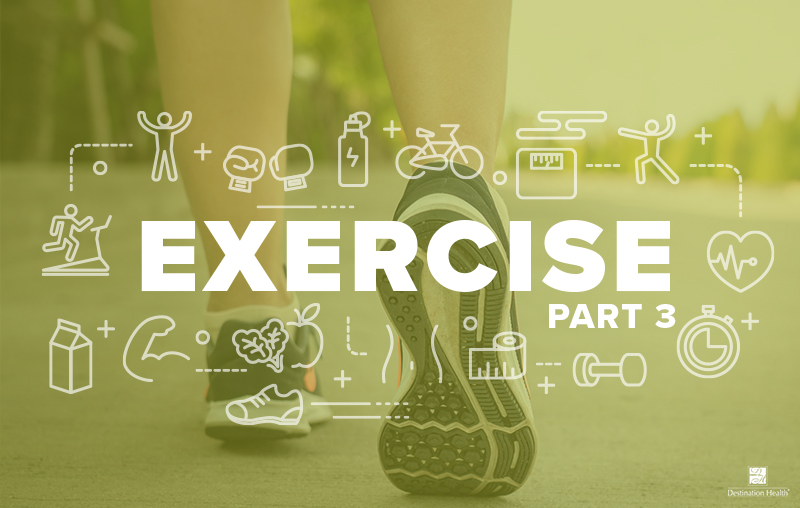PART III: AEROBIC EXERCISE
Written by Dr. Carl DuCharme
During part III of our Exercise Series we define what aerobic exercise is, examine its health benefits and finally, explore how to implement it into our lives.
According to Health.gov, about one half of Americans have a chronic disease that is fully preventable with regular exercise. Current national guidelines call for a minimum of 150 minutes a week of moderate-intensity or 75 minutes a week of vigorous-intensity physical activity. These guidelines also state that going beyond 300 minutes (5 hours) of moderate-intensity physical activity a week has additional health benefits.
What is aerobic exercise?
Aerobic exercise is commonly referred to as cardiovascular exercise or for short, cardio. This is because it utilizes your cardiovascular and respiratory systems to improve your body’s ability to use oxygen. During prolonged exercise at low-to-moderate intensity your heart and lungs have to work harder to keep blood, oxygen and nutrients flowing to those muscles being worked and throughout your body. The end result is overall improved levels of health and cardiorespiratory fitness. This is partly because when your body is more efficient at utilizing oxygen during stress i.e. exercise, it also becomes more efficient while at rest. Therefore, at rest your body will have improved blood flow, lower resting heart rate and lower respiratory rate.
Common types of aerobic exercise:
- Jogging or brisk walking
- Cycling
- Swimming
- Rowing
- Dancing or Zumba
What are the health benefits of aerobic exercise?
Multiple studies have demonstrated that modest aerobic physical activity will reduce all-cause mortality and may increase life expectancy. A sedentary lifestyle is amongst the leading contributors to cardiovascular disease (CVD). CVD is the number one killer in America, causing around 600,000 deaths each year. Additionally, cardiorespiratory fitness levels are inversely related to death rates even amongst those with cardiovascular risk factors such as obesity, smoking, high blood pressure and high cholesterol.
The higher your cardiorespiratory fitness level = the lower your chance of dying
Those suffering from coronary artery disease have been found to benefit greatly with aerobic exercise. Research has shown regular physical activity can lead to atherosclerotic plaque regression. In laymen’s terms, this is reversing built up plaque in the arteries of the heart.
The American Heart Association recently reported regular aerobic exercise will lower systolic blood pressure (the top number) 7 points and diastolic blood pressure (the bottom number) 5 points amongst patients with high blood pressure. To me that sounds better than taking a pill every day!
Aerobic exercise even influences diabetes and the hallmark of prediabetes, insulin resistance. The more aerobic exercise you do, the more glucose your muscle cells take into their cells. This helps improve insulin sensitivity. It has been shown that even one single episode of low-intensity activity burning 350 calories will significantly improve insulin sensitivity the next day. Now imagine if you can do that several days per week, many people would not have to be on medications to help control blood sugar!
Aerobic exercise lowers the risk of the following diseases:
- Cancer (13 different types)
- Dementia
- Cardiovascular disease
- Diabetes
- Obesity
What is the optimal amount of exercise?
It has been reported that 50-60 minutes of daily vigorous exercise will provide the maximal reduction in mortality risk. However, even short bouts of daily exercise will reduce mortality. One study looking at over 400,000 people indicates that 15 minutes of daily moderate-intensity exercise reduced all-cause mortality 14% and increased life expectancy 3 years. Additionally, this study indicates meeting the suggested guidelines of 150 minutes of moderate-intensity exercise weekly increases life expectancy 7 years when compared to those who do not exercise.
Moderate-intensity exercise is equivalent to walking briskly (>3.5 mph), whereas low-intensity exercise is walking at a slower pace (3 mph). Examples of vigorous-intensity exercise are jogging 5 mph, cycling faster than 10 mph or freestyle swimming.
PLAN INTO ACTION
As with any exercise regimen, set realistic goals and expectations for yourself. If you are currently sedentary or exercise minimally do not set your goal at 150 minutes of exercise per week. A good starting point will be 90 minutes of aerobic exercise per week if you are just starting. Once you get this mastered and your body becomes accustomed to it you can increase the amount.
For beginners, please refer to Part 1 of this Exercise Blog Series for recommendations on how to get started with walking.
For most others, the simplest way to get at least 150 minutes of moderate-intensity aerobic exercise per week is… WALKING! This is because you can literally leave your front door and start today. There is no requirement for owning a treadmill, swimming pool, bicycle or a gym membership. Remember, we are trying to build healthy, life-long habits that fit seamlessly into your day. Maybe you can fit a brisk 30-minute walk on your daily lunch break, prior to work or after dinner. Perhaps your best solution is 30 minutes on Friday after work and 60 minutes per brisk walk on Saturday and Sunday. The minimum of 150 minutes is a cumulative weekly goal.
An alternative plan is targeting at least 75 minutes weekly of vigorous-intensity aerobic activity. Traditionally this is performed at 70-85% of maximum heart rate. An easy way to tell if your activity is vigorous or not is the talk test. During vigorous exercise you will not be able to speak a full sentence and only be able to speak a few words at a time. One example of a weekly plan would be jogging (at least 5 mph) or cycling (at least 10 mph) three times per week for 25 minutes.
Health Tip
Keep in mind the above suggestions are the minimum requirements and should be performed in addition to the minimum of twice weekly 30-minute sessions of resistance training. Also, if doing resistance training and aerobic exercise in the same workout you should prioritize resistance training. Start with resistance training after properly warming up before moving on to cardio in order to maximize your health results.
Bonus Health Tip
It is not necessary to perform cardio on an empty stomach to lose fat. While it is true your body may preferentially use ketones and fat as fuel during fasted cardio, it does not amount to greater fat loss than performing cardio in a fed (nonfasted) state. Simply performing cardio, or even resistance training will help produce a calorie deficit that your body will have to account for whether using glucose or ketones as fuel. This, combined with a calorie-restricted diet will force your body to mobilize fat from your body to use as fuel.
Continue following Destination Health for the next blog in our 5-Part Exercise Series where we discuss the significance of Flexibility.


